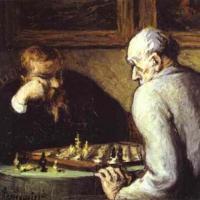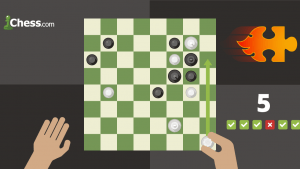
Mental Domination by IM Jeremy Silman
Chess is a perfectly mathematical game where steel-cold calculation wins and emotions are irrelevant, right? Wrong! International Master and famed chess author Jeremy Silman says: "Much has been made of psychology in chess, but rarely have I seen anything about how one player can get inside his opponent's head and make him accept a false image of what's really happening on the chessboard. And, once you buy into your opponent's version of reality, defeat isn't far away. This course is all about making an opponent accept your "orders", while also showing you how you can avoid the same fate by not falling for this kind of subliminal illusion. How often does this kind of thing occur? All the time!"
In his new Chess Mentor course - Mental Domination - Silman gives us 20 crystal-clear examples of how you can alter the reality on the chessboard and use your mental edge to win.
Here is one key example from the course:
This position comes from a game between A.Saidy - R.Russell, National Open 1999, after 1.d4 Nf6 2.c4 g6 3.g3 Bg7 4.Bg2 d6 5.Nf3 O-O 6.Nc3 Nbd7 7.O-O e5 8.e4 exd4 9.Nxd4 Re8 10.h3 a6 11.Be3 Rb8 12.a4 Nc5 13.Qc2 a5 14.Rad1 Bd7 15.Ndb5 b6 16.Rfe1 h6 17.f4 Bxb5 18.axb5 Qe7 19.Bf2 Qf8 20.Kh2 h5 21.Bxc5 bxc5 22.Ra1 h4 23.g4 g5.
Black's last move (23...g5) was a wonderful try since his position was absolutely awful: White has an enormous space advantage, the a5-pawn is dying (which adds a material advantage to the equation), and Black is devoid of counterplay. With 23...g5 Black offers a pawn but hopes to gain many positional and dynamic perks. Black is telling White, "I don't intend to go quietly into the night."
In the actual game, Saidy (a strong, legendary IM) was gliding along happily, quite sure that he would win this game without too much trouble. Black's 23...g5 upset the applecart, and though White maintained an advantage after 24.fxg5 Nh7 25.Nd5 Be5+ 26.Kh1, black's pieces had become quite active and white's King was suddenly a bit loose. In the end, White lost when some errors allowed black's active pieces to get a bit too close.
But what SHOULD white have played? Can you figure it out?
Try making the best moves in the problem below!
Improve your chess now with Chess Mentor - the most effective interactive chess training system ever created!
- Boost your rating and tournament performance
- Improve your tactics and strategies
- Learn how Grandmasters think about each move
Why is Chess Mentor Unique?
Chess Mentor gives you feedback on every possible move on the chessboard!
In-depth Analysis of Every Position: Chess Mentor gives you more than just problems and answers - you have many different tools and hints to help you arrive at the solution on your own. Most importantly, Chess Mentor gives you feedback on every possible move on the chessboard so you not only know the right answer, but why each other move was wrong.
 “The only chess program I’ve ever seen which asks all the questions, and has all the answers and explanations. Any player, from novice to expert, finally has the chance to improve by leaps and bounds!”
“The only chess program I’ve ever seen which asks all the questions, and has all the answers and explanations. Any player, from novice to expert, finally has the chance to improve by leaps and bounds!”
GM Walter Browne - Six-time US Champion
Lessons by Top Instructors: Chess Mentor lessons are written by chess professionals and teachers such as GM Walter Browne, GM Nick deFirmian, IM Jeremy Silman, IM John Grefe, IM Eric Tangborn, IM Marc Leski, FM Thomas Wolski, FM Mike Arne, and FM Craig Mar.
Customized Personal Lessons: Chess Mentor's unique responsive learning engine it is just like studying with a real chess coach. Lessons are customized for your needs and your progress is tracked to show you how you are improving.
Key Features
- Unique chess lessons by professional coaches like IM Jeremy Silman
- Customize your learning experience by choosing specific themes, courses, and goals
- Highlights themes, important squares, and key pieces in the position
- Gives feedback on all of your available moves, not just the correct move
- Measures progress and scores on individual problems and overall progress


